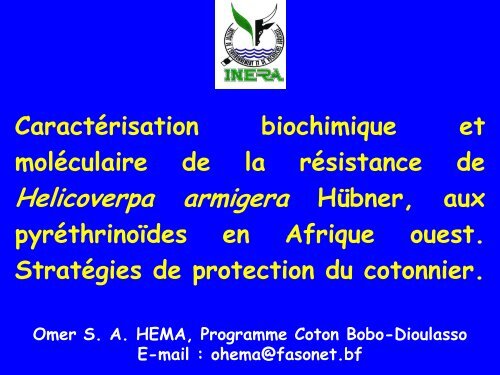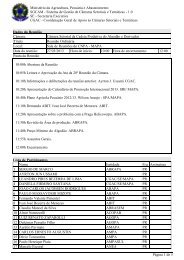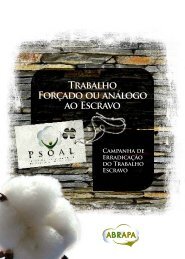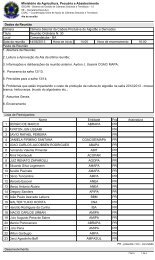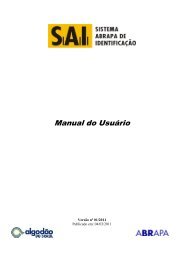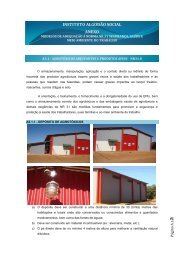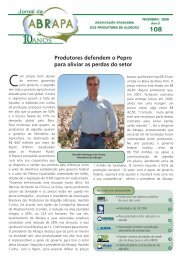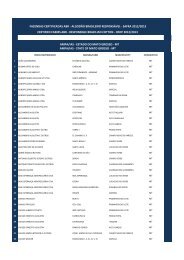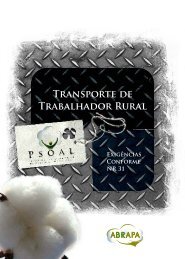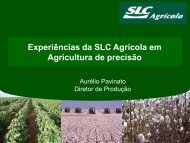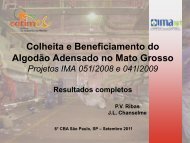Caractérisation biochimique et moléculaire de la ... - Abrapa
Caractérisation biochimique et moléculaire de la ... - Abrapa
Caractérisation biochimique et moléculaire de la ... - Abrapa
- No tags were found...
You also want an ePaper? Increase the reach of your titles
YUMPU automatically turns print PDFs into web optimized ePapers that Google loves.
Caractérisation <strong>biochimique</strong> <strong>et</strong>molécu<strong>la</strong>ire <strong>de</strong> <strong>la</strong> résistance <strong>de</strong>Helicoverpa armigera Hübner, auxpyréthrinoï<strong>de</strong>s en Afrique ouest.Stratégies <strong>de</strong> protection du cotonnier.Omer S. A. HEMA, Programme Coton Bobo-Diou<strong>la</strong>ssoE-mail : ohema@fason<strong>et</strong>.bf
PLAN DE L’EXPOSÉ‣Introduction‣Objectifs <strong>de</strong> l’étu<strong>de</strong>‣Matériels <strong>et</strong> métho<strong>de</strong>s‣Résultats‣Conclusion
INTRODUCTIONCoton => 50% exportations totales BurkinaPlusieurs ravageurs attaquent cotonnier =>pertes récolte moyennes 50-60%Helicoverpa armigera, lépidoptère <strong>la</strong>rvepolyphage (coton, gombo, niébé, maïs, sorgho,cucurbitacées, tomate…) = principal ravageur
Lutte chimique <strong>de</strong>puis les années 1980 avecpyréthrinoï<strong>de</strong>s => plusieurs avantages :– faible coût– faible persistance dans environnement– bonne efficacité sur cible à dose basse– faible toxicité pour utilisateur.Vers 1990, perte efficacité pyréthrinoï<strong>de</strong>scontre H. armigera en Afrique <strong>de</strong> l’ouest
Objectifs étu<strong>de</strong>s‣Situer niveaux résistance <strong>de</strong>ltaméthrine parapplication topique => DL50‣Déterminer activités enzymatiques =>mécanismes <strong>biochimique</strong>s impliqués dansrésistance H. armigera pyréthrinoï<strong>de</strong>s Burkina‣Déterminer mécanisme molécu<strong>la</strong>ire => gènesresponsables résistance‣Proposer solutions alternatives
MATERIELS ET MÉTHODES
Matériel végétal‣Variété locale convent FK37‣Variété USA convent DP50‣Variétés USA BOLLGARD II ou FK37BGIIInsectes02 souches sensibles pyréthrinoï<strong>de</strong>s : BK77 <strong>et</strong> Heliar21 Souches terrain collectées entre 2003 <strong>et</strong> 2010Burkina Faso Bénin <strong>et</strong> Mali dont 17 Burkina Faso, 02Mali <strong>et</strong> 02 Bénin
MéthodologieBio-essais‣Application topique => <strong>de</strong>ltaméthrine‣Contamination diète => toxine CryMétho<strong>de</strong> <strong>biochimique</strong>‣Extraction broyat <strong>la</strong>rves 10-15 mg‣Dosage activités oxydases, estérases <strong>et</strong>gluthation-S-transférases point final oucinétique au spectrophotomètre entre 340<strong>et</strong> 630 nm
Métho<strong>de</strong> molécu<strong>la</strong>ire‣Extraction <strong>et</strong> dosage ARN total‣Production <strong>de</strong> cDNA par transcriptionreverse‣PCR quantitativeEfficacité toxines au champ‣Sites d’expérimentation : stationsINERA Farako-Bâ, Kouaré, Saria
‣Traitements comparés : 04 obj<strong>et</strong>s‣Conv. USA sans trait lépidoptères‣Transg. USA sans trait lépidoptères‣Conv. Locale sans trait lépidoptères‣Conv. Locale traitements vulgarisés‣Observations directes ravageurs, ASM <strong>et</strong>récolte
Analyse données‣Bio-essais : Win dl (DL10, DL50, DL90)‣Biochimie : XLSTAT‣Bio mol: geNorm, qBase <strong>et</strong> test Stu<strong>de</strong>nt‣Efficacité Bt : ANOVA sur XLSTAT
QUELQUES RESULTATS
Bio-essais <strong>de</strong>ltaméthrineMortality(%)210-1807060403020DL90DL50DL10-20.0001 0.001 0.01 0.1 1 10 100 1000 10000AngaradébouDatomoDiaboKitaKoutia<strong>la</strong>BK77Doses of <strong>de</strong>ltam<strong>et</strong>hrin
ProbitBio-essai Cry1Ac2Mortality (%)DL9010-1807060403020x¤¤x¤x¤ ¤xxDL50DL10-2Doses of Cry1Ac1e-06 1e-05 0.0001 0.001 0.01 0.1 1 10 100¤ BK77 x Composite
ProbitBio-essai Cry2Ab22Mortality (%)DL9010-1807060403020¤ ¤ ¤x¤ ¤¤ ¤ x x x xxxDL50DL10-2Doses of Cry2Ab20.001 0.01 0.1 1 10 100 1000 10000 100000¤ BK77 x CompositeFig. 3 : Linear regression line log dose probit response for Cry2Ab2
ProbitBio-essai <strong>de</strong>ltaméthrine2Mortality (%)180¤DL900-17060403020¤¤¤¤xx x x x xDL50DL10-2Doses of <strong>de</strong>ltam<strong>et</strong>hrin0.001 0.01 0.1 1 10 100 1000 10000 100000¤ BK77 x Composite
Analyse statistique donnéesz obser z critic Prob SignifCry1Ac 1.143 1.960 0.253 NSCry2Ab2 1.156 1.960 0.248 NSDeltam -2.739 1.960 0.006* HS
Activités enzymatiquessouches Oxydases Esterase α Esterase βGSTBK77 2.337 d 0.201 b 0.228 a 0.136 cBAL04 5.338 a 0.292 a 0.193 b 0.188 aBIT04 3.530 c 0.232 ab 0.216 ab 0.176 abDAT04 5.647 a 0.266 a 0.206 ab 0.164 bPO04 4.452 ab 0.263 a 0.179 c 0.131 cTIE04 3.962 b 0.266 a 0.188 bc 0.173 ab
Surexpression gènes P450Souches Gènes CYP surexpressimés >10×/Heliar Origine FRANG 6AE11* 4M6* 332A1* 4M7* 9A12* Bénin 21BEN 6AE11* 9A12* 4M7* 4L5 4M6* Bénin 313DAT 6AE11* 4M7* 9A12* 4M6* 337B1 Burkina 19DIA 6AE11* 4M6* 9A12* 332A1* 4M7* Burkina 11KIT 6AE11* 9A12* 4M6* 4M7* 337B1* Mali 11KOU 6AE11* 4M6* 9A12* 332A1* 4M7* Mali 15
Efficacité du cotonniertransgénique BOLLGARD II
Earias insu<strong>la</strong>naCarpophagesE. bip<strong>la</strong>gaHelicoverpa armigeraDiparopsis watersiD. castanea
0,12Helicoverpa Diparopsis Earias0,10,080,060,040,020FK37 BGII,nt FK37,pv FK37,ntNombre moyen <strong>de</strong> chenilles <strong>de</strong>s capsules par p<strong>la</strong>nt en2006 sur les trois sites (Farako-Bâ, Kouaré <strong>et</strong> Saria)
Syllepte <strong>de</strong>rogataPhyllophagesSpodoptera littoralisAnomis f<strong>la</strong>va
0,06Syllepte Anomis Spodoptera0,050,040,030,020,010FK37 BGII,nt FK37,pv FK37,ntNombre moyen <strong>de</strong> chenilles <strong>de</strong>s feuilles par p<strong>la</strong>nt en2006 sur les trois sites (Farako-Bâ, Kouaré <strong>et</strong> Saria)
(%)Taux capsules saines capsules percées
Ren<strong>de</strong>ment coton graine <strong>de</strong> <strong>la</strong> FK37140012001000128911299671055800791731686 664 6646004002000FK37 BGII, nt FK37, pv FK37, ntFarako-Bâ Kouaré Saria
Conclusion - perspectives‣Niveaux résistance souches terrain 11-43fois ;‣Enzymes surexprimées : oxydases <strong>et</strong> GST ;‣Efficacité cotonnier transgénique exprimant02 <strong>de</strong>lta-endotoxines Cry1Ac <strong>et</strong> Cry2Ab2 ;‣Pas <strong>de</strong> variation niveau résistance toxines Btaprès 04 années culture ;‣Exploration GST pour mieux comprendre ;‣Mise p<strong>la</strong>ce accompagnement pour durabilitétechnologie BOLLGARD II.
Obrigado


